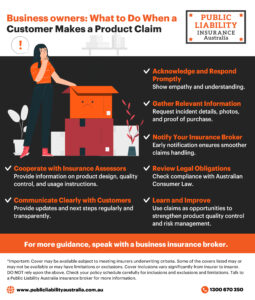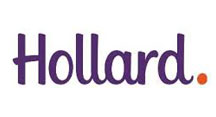 Handling a customer claim about your product can be a challenging experience for any business owner. Whether the claim is about an injury or property damage caused by your product, taking the right steps may protect your business while maintaining your reputation. Here’s a guide to help you navigate this process effectively:
Handling a customer claim about your product can be a challenging experience for any business owner. Whether the claim is about an injury or property damage caused by your product, taking the right steps may protect your business while maintaining your reputation. Here’s a guide to help you navigate this process effectively:
- Acknowledge the Claim and Respond Promptly
When a customer makes a claim, acknowledge their concerns immediately. A timely and professional response demonstrates your commitment to resolving the issue. Avoid admitting fault at this stage but show empathy and understanding for their experience.
- Gather Detailed Information
Request the customer to provide all relevant details about the incident. This may include:
- A clear description of the issue.
- Photos or videos of the product and the damage or injury caused.
- Receipts or proof of purchase.
Keeping detailed records of all communications and evidence is essential for tracking the claim and supporting your case if needed.
- Notify Your Insurance Broker or Provider
Inform your insurance broker or provider about the claim as soon as possible. If you have product liability insurance, this policy may help cover legal and financial costs associated with the claim, including compensation and legal fees.
Your broker can guide you through the claims process and liaise with the insurer on your behalf, helping to ensure the matter is handled professionally and efficiently.
4.Assist and Cooperate with the Insurer, your Broker and Appointed Assessor(s)
The insurer may carry out an investigation to determine the validity of the claim and if you are liable. You may be asked to provide information such as:
- The product’s design, manufacturing, and quality control processes.
- Whether proper usage instructions or warnings were provided.
- Past customer complaints or similar incidents.
This investigation may help identify whether the issue stems from your business operations or external factors.
- Review Legal Obligations.
Depending on the claim outcome or circumstances, you may wish to review your legal obligations. As a business owner in Australia, you must comply with consumer protection laws under the Australian Consumer Law (ACL).
Consult a legal professional to understand your obligations and ensure compliance.
- Communicate Clearly with the Customer
Once a claim has been lodged, you can provide the claim reference to your customer and advise them that they may be contacted by the insurer. If you have chosen not to lodge a claim and are handling the matter privately, be transparent about the next steps and any remedies you intend to offer. Whether you’re resolving the issue directly or referring it to your insurer, maintaining open and respectful communication can help preserve your business relationship.
- Learn and Improve
Customer claims provide valuable insights into potential weaknesses in your product or processes. Use the experience to:
- Improve quality control measures.
- Revise product instructions or warnings.
- Strengthen your risk management practices.
Proactive steps may reduce the likelihood of future claims and demonstrate your commitment to delivering high-quality products.
- Consider Insurance as Part of Your Risk Management Strategy
Having product liability insurance in place may protect your business from significant financial losses due to claims. Speak with a business insurance broker to understand the coverage options available and ensure your policy aligns with your business risks.
Handling customer claims about your product may be a complex process, but with the right approach, you can minimise risks and maintain your business’s reputation. If you’re unsure about your insurance needs, consult with a business insurance broker to explore how suitable coverage may protect your business.
Disclaimer: The content of this blog article is intended for general informational purposes only and should not be considered as professional advice. While we strive to ensure accuracy, we make no guarantees about the completeness or reliability of the information. For guidance regarding what and how much public liability insurance cover you need, we recommend consulting with a business insurance broker. Any actions you take based on any information provided here are at your own discretion.





